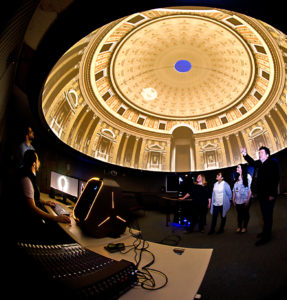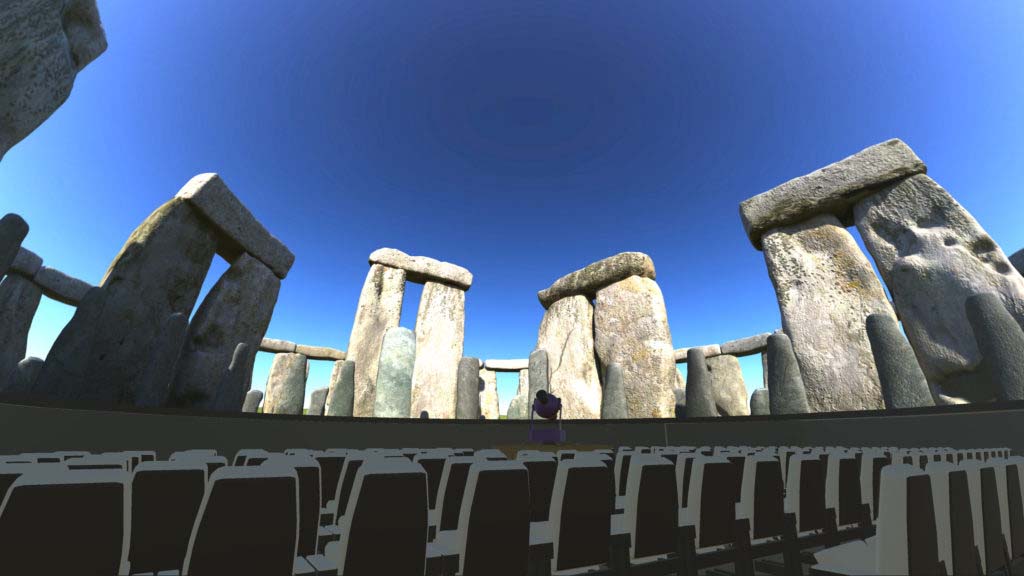
OLD PLANETARIUM REVAMPED INTO CUTTING-EDGE STUDIO
Months after the opening of the Charles W. Brown Planetarium, Ball State has found a new use for its almost 50-year-old predecessor. The dome-shaped room in the basement of the Cooper Science Complex has become a production facility dedicated to developing new shows for planetariums nationwide.
“This is an exciting opportunity for us,” said planetarium director Ron Kaitchuck, “because the last thing we wanted was for the old planetarium to become a storeroom.”
To make use of the space, Kaitchuck and his staff first needed to outfit it with a new digital projector. Helping him secure funding for the device was John Fillwalk, director of Ball State’s Hybrid Design Technologies, a division of the Office of Information Technology that seeks out partnerships injecting the arts into STEM education. More commonly known as STEAM, the acronym stands for science, technology, engineering, arts and mathematics.
“We saw the dome as a valuable space where we could create new content — the kind that’s hard to test on flat-screen computer monitors,” said Fillwalk, who’s also director of the Institute for Digital Intermedia Arts (IDIA), a lab specializing in creating virtual reality and 3-D simulations for a broad range of clients including UNESCO, other universities and the History Channel.
Kaitchuck said Fillwalk’s expertise — as well as that of his student and professional designers — will let planetarium staff and students in the Department of Physics and Astronomy create shows they couldn’t otherwise. “For instance, we don’t know how to craft 3-D models, but John does.”
“And I’m not a scientist, but Ron is,” Fillwalk said. “So there’s a nice synergy at play where he advises us on the science side of these productions and we create the graphics.”
AN ENTREPRENEURIAL VENTURE IN THE MAKING
While the partnership is new this year, Dayna Thompson, assistant planetarium director, looks forward to seeing how the IDIA Lab helps improve shows Ball State is already creating.
One goal is to generate more revenue from the productions. Take, for example, “Saturn & Beyond,” which recently sold to a distribution company for $18,000. “Had we been able to work with IDIA on that, we could have included more graphics to help explain the science that the program talks about,” she said.
Helping assist with the creation of “Saturn & Beyond” was physics and astronomy student Monique Gabb, a Florida native completing her master’s degree who wants to work for a government-backed science and engineering research lab like Argonne. “Astronomy is a great gateway to getting people interested in science, so I enjoyed helping create a show like this.”
Gabb said when it came time to test “Saturn” for audiences, it was a challenge to get large blocks of screen time inside the 52-foot domed Brown Planetarium. “There are so many shows going on over there, it was hard to work us in.” With the conversion of the old planetarium into a new production dome, “we no longer have to worry about that issue.”
Kaitchuck said the size of the old planetarium is also major boon for its new use. “As far as I know, no other planetarium in the country has at its disposal a 30-foot dome for production purposes only,” he said, noting New York City’s Hayden Planetarium, inside the American Museum of Natural History, uses a production dome a fraction of that size.
IDIA TO CREATE NEW, INTERACTIVE CONTENT
Fillwalk has his own aspirations for the old planetarium, now that he’s helped transform it into a studio — one equipped with game-engine computers and a digital projector encased inside a protective fabricated display created by IDIA artist and Ball State alumnus Chris Harrison, ’10, MS ’12.
Most of Fillwalk’s plans involve using the space to help IDIA expand upon — and reshape — content the lab has created for past projects, including virtual simulations of Stonehenge and other ancient ruins in various celestial alignments. “It’s a great opportunity for us to test what we already do in another immersive environment. A dome gives you the same kind of view you’d see with a head-mounted, immersive display, but now we don’t have to wear goggles to get it.”
IDIA is also exploring development of dome-spaced content for new clients including museums and aerospace companies. “My biggest interest is finding ways to allow audiences to be more interactive with these kinds of show,” Fillwalk explained. “If you could hold your phone up as you’re watching, and have a planet or star jump out at you — I think kids would love that.”
OPPORTUNITIES FOR EDUCATION
Closer to home, Fillwalk and his team are working with Thompson on projects for the Brown Planetarium, which in its first year had about 20,000 visitors — more than the double the number of people who visited the old planetarium in its last full year of operation.
For the planetarium’s show, “Black Holes, Worm Holes, and the Movies,” IDIA artists visualized travel through a worm hole, which scientists consider to be a shortcut connecting two distant points in space-time. And for an upcoming Halloween show, Fillwalk and his staff will create graphics illustrating the history of the holiday and its astronomical origins.
Kaitchuck wants to use the old planetarium for future entrepreneurial learning opportunities that will let students outside his department help create new planetarium shows. “We could use music media production students for the audio, creative writing majors to help with scripts — it could be a very diverse group,” he said. “And now, with John’s help, the kinds of work we’ll be able to do … well, the sky really is the limit.”
By Gail Werner
DOME Lab photographs courtesy of Ball State University, Division of Strategic Communication

